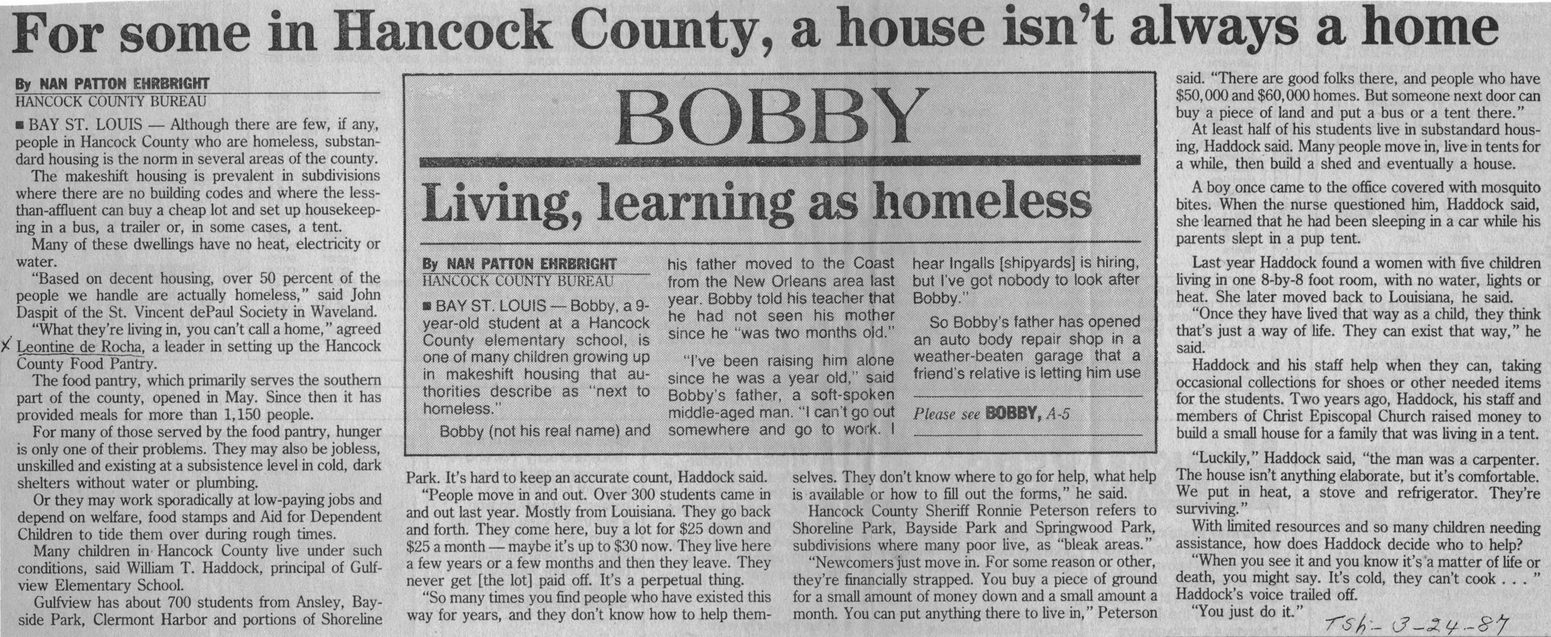This text was obtained via automated optical character recognition.
It has not been edited and may therefore contain several errors.
For some in Hancock County, a house isn’t always a home By NAN PATTON EHRBRIGHT HANCOCK COUNTY BUREAU ■ BAY ST. LOUIS — Bobby, a 9-year-old student at a Hancock County elementary school, is one of many children growing up in makeshift housing that authorities describe as "next to homeless.” Bobby (not his real name) and his father moved to the Coast from the New Orleans area last year. Bobby told his teacher that he had not seen his mother since he “was two months old.” “I've been raising him alone since he was a year old,” said Bobby’s father, a soft-spoken middle-aged man. “I can t go out somewhere and go to work. I hear Ingalls [shipyards] is hiring, but I’ve got nobody to look after Bobby.” So Bobby’s father has opened an auto body repair shop in a weather-beaten garage that a friend's relative is letting him use Please see BOBBY, A-5 By NAN PATTON EHRBRIGHT HANCOCK COUNTY BUREAU ■ BAY ST. LOUIS — Although there are few, if any, people in Hancock County who are homeless, substandard housing is the norm in several areas of the county. The makeshift housing is prevalent in subdivisions where there are no building codes and where the less-than-affluent can buy a cheap lot and set up housekeeping in a bus, a trailer or, in some cases, a tent. Many of these dwellings have no heat, electricity or water. “Based on decent housing, over 50 percent of the people we handle are actually homeless,” said John Daspit of the St. Vincent dePaul Society in Waveland. “What they’re living in, you can’t call a home, ” agreed X Leontine de Rocha, a leader in setting up the Hancock County Food Pantry. The food pantry, which primarily serves the southern part of the county, opened in May. Since then it has provided meals for more than 1,150 people. For many of those served by the food pantry, hunger is only one of their problems. They may also be jobless, unskilled and existing at a subsistence level in cold, dark shelters without water or plumbing. Or they may work sporadically at low-paying jobs and depend on welfare, food stamps and Aid for Dependent Children to tide them over during rough times. Many children in Hancock County live under such conditions, said William T. Haddock, principal of Gulf-view Elementary School. Gulfview has about 700 students from Ansley, Bay-side Park, Clermont Harbor and portions of Shoreline Park. It’s hard to keep an accurate count, Haddock said. “People move in and out. Over 300 students came in and out last year. Mostly from Louisiana. They go back and forth. They come here, buy a lot for $25 down and $25 a month — maybe it’s up to $30 now. They live here a few years or a few months and then they leave. They never get [the lot] paid off. It’s a perpetual thing. “So many times you find people who have existed this way for years, and they don’t know how to help them- selves. They don’t know where to go for help, what help is available or how to fill out the forms,” he said. Hancock County Sheriff Ronnie Peterson refers to Shoreline Park, Bayside Park and Springwood Park, subdivisions where many poor live, as “bleak areas.” “Newcomers just move in. For some reason or other, they’re financially strapped. You buy a piece of ground for a small amount of money down and a small amount a month. You can put anything there to live in,” Peterson said. “There are good folks there, and people who have $50,000 and $60,000 homes. But someone next door can buy a piece of land and put a bus or a tent there.” At least half of his students live in substandard housing, Haddock said. Many people move in, live in tents for a while, then build a shed and eventually a house. A boy once came to the office covered with mosquito bites. When the nurse questioned him, Haddock said, she learned that he had been sleeping in a car while his parents slept in a pup tent. Last year Haddock found a women with five children living in one 8-by-8 foot room, with no water, lights or heat. She later moved back to Louisiana, he said. “Once they have lived that way as a child, they think that’s just a way of life. They can exist that way, ” he said. Haddock and his staff help when they can, taking occasional collections for shoes or other needed items for the students. Two years ago, Haddock, his staff and members of Christ Episcopal Church raised money to build a small house for a family that was living in a tent. “Luckily,” Haddock said, “the man was a carpenter. The house isn’t anything elaborate, but it’s comfortable. We put in heat, a stove and refrigerator. They’re surviving. ” With limited resources and so many children needing assistance, how does Haddock decide who to help? “When you see it and you know it’s a matter of life or death, you might say. It’s cold, they can’t cook ...” Haddock’s voice trailed off. “You just do it.” O-2, U-87

Hancock County Food Pantry Article-3-24-1987